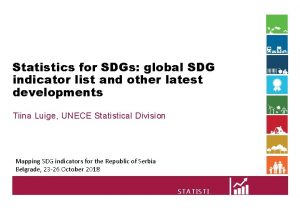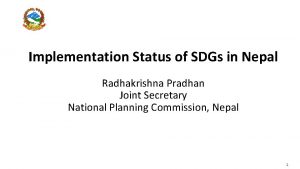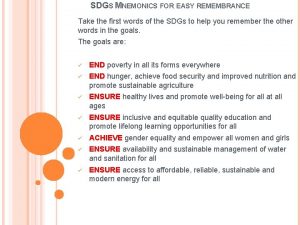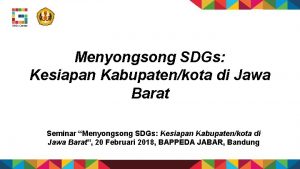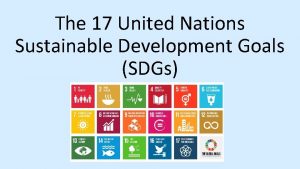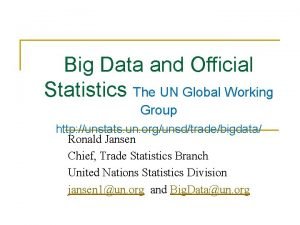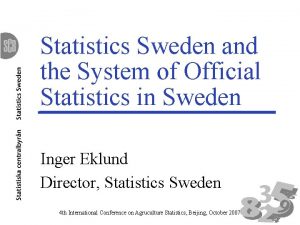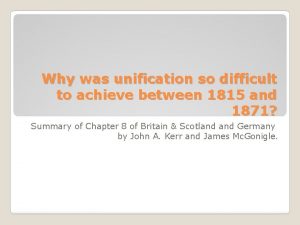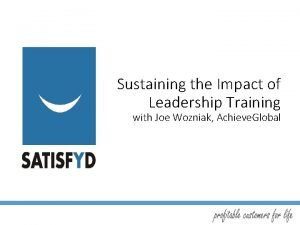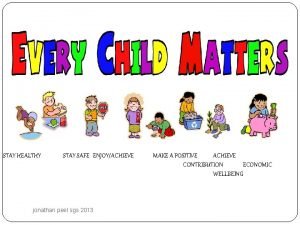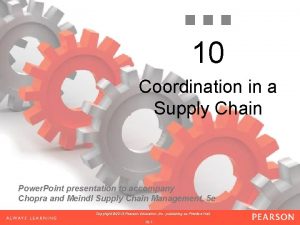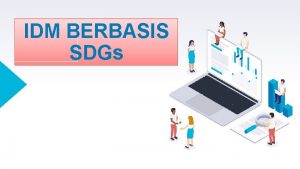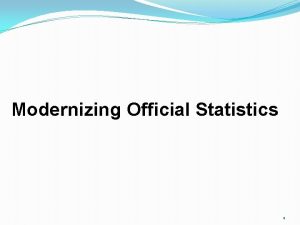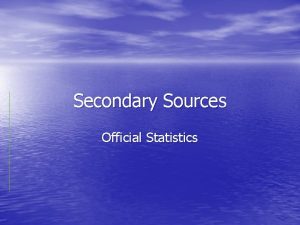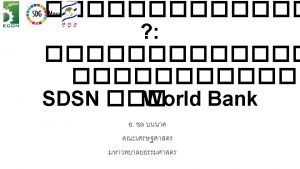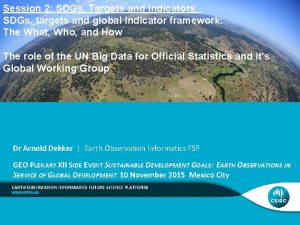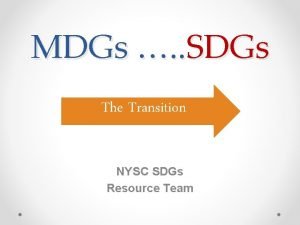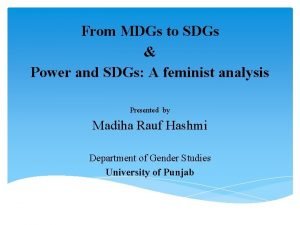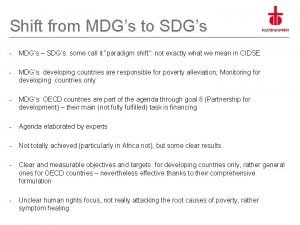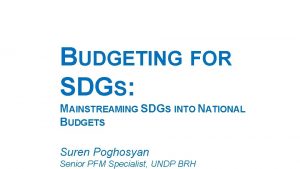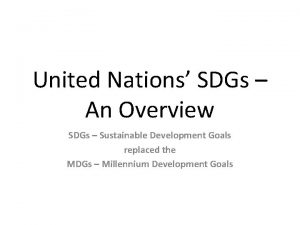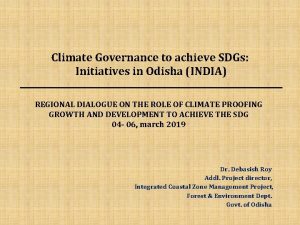Transformations in Official Statistics to Achieve PeopleCentered SDGs






































- Slides: 38


Transformations in Official Statistics to Achieve “People-Centered SDGs” Population Development Composite Index Luay Shabaneh, Ph. D UNFPA Regional Director, Arab States November 2019 Copyright PSA 2

Background • GA resolution 65/234 on the review of ICPD Po. A and its follow-up beyond 2014, underscored the need for a systematic, integrated and comprehensive approach • Called to respond to new challenges to P&D and to the changing ecosystem. • Called to reinforce the integration of the P&D agenda in the global processes • Suggested a new framework for P&D beyond 2014 built on five thematic pillars: 1 - Dignity and human rights 2 - Health 3 -Place and mobility 4 - Governance and accountability 5 - Sustainability

Two main questions • Is SDG agenda people-centered? • Do official statistics systems respond to People-centered SDGs? What transformation is needed to respond?

Definition People-centered SDGs • Putting people first- the right to development for all: moving from satisfying basic needs to right based approach • People from all walks have a say and able to demand corrective actions from policy makers • People are at the center, and measuring the progress of SDGs is scaled by proxy progress on the life and wellbeing of people and their rights • Official statistics is People-centered when putting people rights in the design and implementation if official statistics and regularly collect and disseminate high quality data that enables people-centered SDG monitoring.

Was Official Statistics People-Centered during MDG 1990 -2015 • Measured and monitored at outcome level (poverty level, unemployment, MMR, U 5 M, etc. . ) • Failed to provide warning system on track of development (inequalities, Gender parities, generational disparities, etc. ) Not People-Centered

Operationalization of people-centered - PDCI Construct an index composing a set of mostly SDG indicators within the context of the ICPD framework beyond 2014 A scientific measure and policy tool to advocate for peoplecentered SDGs Demonstrate quantitatively the importance of accommodating population agenda as a key enabler for achieving SDGs.

Conceptual framework Thematic Dimensions for ICPD/Po. A Beyond-2014 Source: United Nations, 2014. “Framework of Actions for the follow-up to the ICPD-Po. A Beyond 2014”

Indicator Selection • SIX criteria: 1)Relevance for monitoring 2)Repeatable: across time and country 3)Reliable 4)Data quality. 5)Updated regularly. 6)Coverage: Availability for at least 75% of the countries UNFPA/ASRO Listed 39 priority P&D Indicators from SDG indicators

Indicators integrated into the conceptual framework • Initially, 46 indicators were identified to construct the composite index, 8 were dropped during statistical validation; • 38 indicators were assigned across the five dimensions as follows: - dignity and human rights (13 indicators), - Health/ SRH (7); - Place and mobility (5); - Governance and Accountability (6); and - Sustainability (7). • Assigning indicators to the five dimensions in accordance to the report of the Secretary-General on the ICPD themes presented in the 47 th sessions of the CPD in 2014.

Component Level Framework Dignity and human rights Gender equality Adolescents & youth Poverty & inequality Population ageing Non-discrimination Health (SRH) Governance and accountability Place and mobility SRH, including maternal health Cooperation and partnerships International migration SRH of young people Contraception and unmet need for FP Participation e. g. civil society, Women & youth Internal migration and urbanization HIV/AIDS and STI Integrating population dynamics into development planning Strengthening knowledge and accountability IDPs and refugees Sustainability Population dynamics Environmental sustainability Climate change

Coverage and Data Sources • Coverage: Composite Index is computed for the 22 Arab countries. • Statistical testing and multi-collinearity diagnostics conducted for 157 countries with completed data out of 195 on the UN databases; • Procedures established for data imputation for Arab Countries • Data Sources: UN databases e. g. UN-DESA, UNICEF, ILO, World Bank, WHO, …etc. • Complementary data, collected through UNFPA COs in the Arab region.

Missing data imputation • Cross-country regression model based on data from 157 • Estimation by the average of the countries in similar conditions • Computation using micro datasets

Data Limitations Data gaps were largely concentrated in indicators related to: • Discrimination against disabled persons and migrants, • Harassment and human trafficking, • Supporting environment for older persons, • Disparities between urban and rural communities, • Urbanization and internal migration, • Labor rights protections, • Engagement of civil society, • Women empowerment to make their own informed decisions regarding SRH • Sustainable human settlement planning.

Dignity and Human rights Indicators FGM prevalence (%) among girls aged 15 -19 Child marriage by age 18 (% of women ages 20 -24 who are married before 18) Women ever experienced Domestic physical violence Gender Parity Index for secondary education Female to male labor force participation rate (%) Share of seats in parliament (% held by women) Youth unemployment rate (ages 15– 24) Share of seats in parliament (% held by members aged under 40) Vulnerable employment (% of total employment) Proportion of population living below the national poverty line (%) Secondary school dropout rate among youth Freedom of choice Old-age pension recipients

Health/ SRH Indicators Neonatal Mortality rates Proportion of births attended by skilled health personnel Antenatal care coverage- at least four visits Adolescent birth rate Providing school-based sexuality education. Unmet need for family planning HIV prevalence adult Neonatal Mortality rates

Place and Mobility Indicators Measures on integration of immigrants Refugees and IDPs by country of origin (% of population) Proportion of urban population living in slums Estimated direct deaths from major conflicts (per 100 000 population) Country in a conflict Measures on integration of immigrants

Governance and Accountability Indicators Birth registration (% under age 5) Countries that have conducted population and housing census in the last 10 years Country adopted National Population related issues policies Proportion of individuals using the Internet Country adopted and implement constitutional statutory and/or policy guarantees for public access to information Country has an independent national human rights institution in compliance with the Paris Principles

Sustainability Indicators Renewable energy consumption (% of total final energy consumption) Homeless people due to natural disaster (average annual per million people) Household and ambient air pollution (per 100000 population) Research and development expenditure (% of GDP) Adoption and Implementation of national DRR strategies in line with the Sendai Framework GDP annual growth - Population annual growth Population using improved sanitation facilities

Calculating the index scores (Normalization) a) upper and lower bounds identified b) variables were transformed linearly to 0 - 100 scale; using the formula:

Calculating the index scores (Weights) • The literature identifies four main approaches to designing weights: 1. Equal weights √ Weights’ schemes 2. Mathematical weights √ Expert 3. Expert weights Equal Mathematical weights re e w s ght i e w e l equa ned for th assig ors within t a c i ion d s n in e dim h c a e Dignity and Human rights Health Place and Mobility Governance Sustainability Total weights (PCA) 0. 20 1. 00 0. 207 0. 204 0. 201 0. 214 0. 174 1. 000 (results oriented) 0. 29 0. 14 1. 00

Aggregation within & across dimensions • Within each dimension, normalization standardized values across indicators, Therefore: Within dimension arithmetic mean was utilized across indicators • On the other hand, dimensions represent diversity of issues Therefore: For compiled dimensions, the geometric mean adopted

Statistical Soundness and Validation

Reliability test for internal consistency between the indicators • Cronbach’s alpha is used to estimate reliability, or internal consistency, of a composite score. High Cronbach’s alpha, or equivalently a high “reliability”, indicates that the individual indicators measure the latent phenomenon well. • Accordingly, inter-item consistencies are: high (> 0. 7) for 2 dimensions: Dignity and Human rights and Health), moderate (0. 4 < x < 0. 7) for the Reliability test (Cronbach’s alpha) for each dimension Dimension Number of Items Scale reliability coefficient 0. 85 Dignity and Human rights 14 Health 8 0. 78 Place and Mobility 5 0. 44 Governance 5 0. 40 Sustainability 10 0. 58

Testing the Collinearity /redundancy • Pearson's Correlation Coefficient, a measure of the linear relationship between two quantitative, continuous variables. Cut-off strong correlation 0. 7. • Collinearity among indicators is tested, to determine which of the correlated indicators would be excluded.

Excluded Indicators Dignity Youth literacy rate (% of ages 15– 24) Healthy life expectancy at birth Health/SRH: Maternal mortality ratio Sustainability: Access to electricity Access to clean fuels & technology for cooking Population using improved drinking-water sources

Sensitivity/Robustness tests • Testing the Sensitivity/Robustness is necessary to explore the extent to which ranking is robust regarding the choice of alternative weighting schemes, the aggregation methods and the upper and lower bound used in the normalization procedure. Changing the lower bound “worst” (=0) Results indicate that the differences in country ranks ranged between 0 and 2 ranks. Changing the aggregation method among dimensions countries kept the same rank while some varied by one rank and a single country differed by three ranks.

Using Different Weighting Schemes

Main Findings

Scores by Dimension by Country Algeria Bahrain Comoros Djibouti Egypt Iraq Jordan Kuwait Lebanon Libya Mauritania Morocco Oman Palestine Qatar Saudi Arabia Somalia Sudan Syria Tunisia UAE Yemen Dignity 59. 3 68. 4 47. 9 46. 1 49. 1 51. 6 52. 2 64. 2 50. 1 52. 8 43. 2 52. 8 58. 8 39. 6 66. 5 61. 0 27. 6 35. 5 40. 0 61. 6 70. 3 26. 9 SRH 68. 6 93. 7 55. 8 57. 1 81. 0 52. 7 74. 3 75. 5 87. 8 65. 8 37. 8 73. 2 89. 1 85. 5 75. 8 70. 8 22. 2 43. 7 64. 9 70. 6 74. 2 31. 7 Mobility 83. 7 92. 7 64. 8 64. 3 83. 9 51. 3 90. 5 75. 3 72. 8 50. 2 68. 1 97. 1 91. 7 61. 2 79. 6 76. 0 28. 8 51. 8 35. 6 78. 0 79. 6 42. 9 Governance 82. 9 83. 0 63. 1 71. 5 65. 8 67. 1 71. 8 65. 3 74. 4 19. 3 69. 0 86. 9 80. 5 66. 9 84. 7 81. 2 23. 8 38. 4 27. 9 81. 5 67. 4 50. 1 Sustainability 59. 3 58. 0 58. 2 43. 5 64. 6 55. 3 48. 5 58. 1 62. 1 55. 0 48. 8 66. 0 59. 7 51. 0 62. 1 51. 4 44. 2 48. 6 52. 5 63. 8 42. 1

n ia al m 30 29. 3 41. 6 42. 4 37. 8 40 So m en ria Sy n da 45. 0 50 Su ya Lib a q ni rit a Ira 51. 8 55. 3 55. 5 57. 6 58. 9 65. 7 67. 3 67. 6 68. 0 68. 2 69. 8 69. 9 70. 8 73. 2 73. 5 90 Ye au M ti ou Dj ib os e 60 m or Co t t n in le st Pa rd a Jo ai w Ku yp Eg Al ge Sa ud ria i A ra bi a Le ba no n Tu ni sia E 70 UA r ta Qa 74. 6 77. 8 80 Om an M or oc co ai hr Ba The Population Development Composite Index (PDCI) High performance Medium Low Performance 20 10 0

PDCI vs HDI selected Countries 90 80 70 60 50 Corr(PDCI, HDI) = 0. 34 40 30 UAE Saudi Arabia Kuwait Qatar Oman Lebanon Bahrain Algeria Tunisia PDCI HDI Egypt Morocco

PDCI Index SPI en m Ye n da Su ti ou Dj ib os or m Co an rd Jo yp t Eg sia Tu ni n no ba Le bi a 40 ra ria 50 A di Sa u ge Al E UA ar Qa t co oc or M an Om PDCI VS SPI 80 70 60 Corr(PDCI, HDI)= 0. 93 30 20 10 0

PDCI SDG n Sy r ia en m Ye da Su q 40 Ira Qa ta r Sa Om ud an i A ra bi Co a m or M os or oc co Dj ib ou ti Ku w a Le it ba no n Eg yp t UA E Al g M eria au rit an ia Tu ni sia Jo rd an n ai hr Ba PDCI vs SDG 80 70 60 50 Corr(PDCI, SDG)=0. 84 30

50 62. 1 64. 6 74. 4 65. 8 78 83. 9 70. 6 81. 5 52. 5 50. 1 49. 1 75 61. 6 81 87. 8 100 72. 8 Different paths lead to similar results: Tunisia, Lebanon & Egypt 25 0 Dignity Health (SRH) Egypt Mobility Lebanon Governance Tunisia Sustainability

PDCI Country Profile- Qatar • PDCI is estimated to 73. 2. • Best dimensional performance is governance and the worst dimensional performance is sustainability. • Qatar’s PDCI was pulled up by gender education parity, using improved sanitation, birth registration, conducting census, public access to information, existence of human rights national institution, and disaster risk reduction strategy indicators. • Qatar’s PDCI pulled down by three indicators; adoption measure on integration of immigrant, providing sexuality education and renewable energy consumption

Conclusions and Recommendations • PDCI is an informative and policy tool people-centered SDG • NSS to routinely collect and disseminate data needed for PDCI • NSS to explore collecting data for many sources and validate to avoid using data from non-official sources

 Daffodil drug
Daffodil drug Subject matter in auditing
Subject matter in auditing Sdgs list
Sdgs list Sdgs 2030
Sdgs 2030 Mnemonics for sdg goals
Mnemonics for sdg goals Elina bardram
Elina bardram Sdgs jawa barat
Sdgs jawa barat Https://sustainabledevelopment.un.org/sdgs
Https://sustainabledevelopment.un.org/sdgs Federation business school
Federation business school Sdg projects ideas
Sdg projects ideas Pilar sosial sdgs
Pilar sosial sdgs Big data official statistics
Big data official statistics Statistics sweden
Statistics sweden Big data official statistics
Big data official statistics Official statistics from mobile phone data
Official statistics from mobile phone data Master emos
Master emos European master in official statistics
European master in official statistics Big data official statistics
Big data official statistics Introduction to statistics what is statistics
Introduction to statistics what is statistics To achieve reliable transport in tcp
To achieve reliable transport in tcp Large secondary group formed to achieve specific goals.
Large secondary group formed to achieve specific goals. Nj achieve principal evaluation
Nj achieve principal evaluation Achieve 3000 kidz biz
Achieve 3000 kidz biz If you can imagine it you can achieve it
If you can imagine it you can achieve it Achieve the core ela
Achieve the core ela Achieve
Achieve Too young to drive achieve 3000
Too young to drive achieve 3000 Why was italian unification difficult to achieve
Why was italian unification difficult to achieve Another word for achieve
Another word for achieve Sandra alberti
Sandra alberti What is the highest lexile score
What is the highest lexile score Longing, strong desire
Longing, strong desire Read to achieve portfolio passages
Read to achieve portfolio passages Achieve the core.org
Achieve the core.org Achieve global leadership training
Achieve global leadership training Be healthy stay safe enjoy and achieve
Be healthy stay safe enjoy and achieve Behavioral obstacles in supply chain
Behavioral obstacles in supply chain How to achieve performance excellence
How to achieve performance excellence Achieve 3000.com login
Achieve 3000.com login


